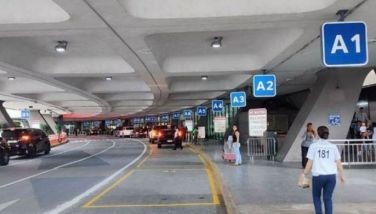Cebu tourism sector hits Seoul link cut
January 24, 2002 | 12:00am
CEBU CITY – A plan by aviation authorities to pare down Cebu’s flight links to Seoul and give the cut frequencies to Manila has drawn flak from the city’s tourism stakeholders.
Dr. Mila Espina, chairperson of the tourism committee of the Cebu Chamber of Commerce and Industry (CCCI), said the plan, if adopted, would be another blow to the city’s tourism sector, which is still struggling to cope with the effects of the negative Japanese travel advisory.
"Manila does not need more frequencies to Seoul since there are already 21 flights per week between them. We do. Cebu desperately needs more direct international links," she said.
"We only have a few international flights and still the CAB wants to give new entitlements to Manila despite excess capacity there. It is quite unfair to Cebu."
She said Cebu’s tourism industry’s which found a lifeline in the Korean market in the wake of the disappearance of Japanese traffic due to Tokyo’s travel ban, is again in peril because of the Seoul flight cut.
Espina’s displeasure over the plan was echoed by Vice Mayor Michael Rama and other industry stakeholders. Rama, who chairs the city’s tourism commission, did not mince words in denouncing aviation authorities.
"Once again, we are shortchanged in favor of Manila," he said. "Here we are doing everything we can to promote tourism to Cebu and the CAB cuts one of our few international services, Where are our priorities?"
He added: "This is another example of the imperialistic attitude of our national officials sitting in Manila. Sila ray magbuot. (They always get their way)."
Air Transportation Office chief Adelberto Yap and fellow Civil Aeronautics Board member Alberto Lim have both been quoted as saying that the CAB wants to allocate three of four new flight entitlements to Korea to Cebu Pacific Airways, which will use them on the Manila-Seoul route.
This means pioneer flag carrier Philippine Airlines will not be able to regularize by March 1 its two extra Cebu-Seoul flights currently covered by temporary permits.
Yap said the board temporarily "lent" two Cebu Pacific entitlements to PAL since the former carrier would be able to mount its Manila-Seoul flights only by March 2, an event that is still uncertain.
"Having just two weekly flights to Seoul leaves us at a gross disadvantage compared with aggressive Asia-Pacific competitors like Bali and Guam. Any reduction in flights is an unwelcome setback for us," said Marisol Barria, president of the Cebu Association of Tour Operators (CATO).
Her views were echoed by Bernadette Jingco, president of the Hotel, Resort and Restaurant Association of Cebu (HRRAC): "The tourism sector is the largest employer of services in Cebu and the impact of a reduction in international flights is felt immediately, unlike Manila which can more readily absorb such a loss. Thousands of jobs are at stake here."
Val Alonzo, president of the Cebu Tour Guide Association (CTGA), said the extensive promotional efforts of the Tourism Department and the travel trade would all go to waste if aviation authorities continued to put barriers to direct services to Cebu.
"There is no substitute for regular direct flights in giving us the ability to attract new visitors," he said.
All three industry leaders, together with the managers of two top Cebu hotels – Ben Bousnina of Shangri-La’s Mactan Island Resort and Randy Baron of Cebu Plaza – have appealed to Transportation Secretary and CAB chairman Pantaleon Alvarez to intervene and reverse the board’s stand.
Earlier, Tourism regional director Patria Aurora Roa called for additional flights on the Cebu-Seoul route, noting that Koreans were now the top foreign visitor group to Cebu. "I would push for this because this is good for Cebu. I hope the CAB will see the wisdom of permitting more flights," she said.
CCCI, CATO, HRRAC and CTGA count as members virtually all travel industry players based in Cebu and the Visayas region, including travel agencies, tour operators, tour guides, hotels, resorts and restaurants.
They comprise the second largest travel industry bloc in the country and are largely responsible for generating tourist inflows to Cebu and southern Philippines – one of the most important tourist destinations in the country.
Dr. Mila Espina, chairperson of the tourism committee of the Cebu Chamber of Commerce and Industry (CCCI), said the plan, if adopted, would be another blow to the city’s tourism sector, which is still struggling to cope with the effects of the negative Japanese travel advisory.
"Manila does not need more frequencies to Seoul since there are already 21 flights per week between them. We do. Cebu desperately needs more direct international links," she said.
"We only have a few international flights and still the CAB wants to give new entitlements to Manila despite excess capacity there. It is quite unfair to Cebu."
She said Cebu’s tourism industry’s which found a lifeline in the Korean market in the wake of the disappearance of Japanese traffic due to Tokyo’s travel ban, is again in peril because of the Seoul flight cut.
Espina’s displeasure over the plan was echoed by Vice Mayor Michael Rama and other industry stakeholders. Rama, who chairs the city’s tourism commission, did not mince words in denouncing aviation authorities.
"Once again, we are shortchanged in favor of Manila," he said. "Here we are doing everything we can to promote tourism to Cebu and the CAB cuts one of our few international services, Where are our priorities?"
He added: "This is another example of the imperialistic attitude of our national officials sitting in Manila. Sila ray magbuot. (They always get their way)."
Air Transportation Office chief Adelberto Yap and fellow Civil Aeronautics Board member Alberto Lim have both been quoted as saying that the CAB wants to allocate three of four new flight entitlements to Korea to Cebu Pacific Airways, which will use them on the Manila-Seoul route.
This means pioneer flag carrier Philippine Airlines will not be able to regularize by March 1 its two extra Cebu-Seoul flights currently covered by temporary permits.
Yap said the board temporarily "lent" two Cebu Pacific entitlements to PAL since the former carrier would be able to mount its Manila-Seoul flights only by March 2, an event that is still uncertain.
"Having just two weekly flights to Seoul leaves us at a gross disadvantage compared with aggressive Asia-Pacific competitors like Bali and Guam. Any reduction in flights is an unwelcome setback for us," said Marisol Barria, president of the Cebu Association of Tour Operators (CATO).
Her views were echoed by Bernadette Jingco, president of the Hotel, Resort and Restaurant Association of Cebu (HRRAC): "The tourism sector is the largest employer of services in Cebu and the impact of a reduction in international flights is felt immediately, unlike Manila which can more readily absorb such a loss. Thousands of jobs are at stake here."
Val Alonzo, president of the Cebu Tour Guide Association (CTGA), said the extensive promotional efforts of the Tourism Department and the travel trade would all go to waste if aviation authorities continued to put barriers to direct services to Cebu.
"There is no substitute for regular direct flights in giving us the ability to attract new visitors," he said.
All three industry leaders, together with the managers of two top Cebu hotels – Ben Bousnina of Shangri-La’s Mactan Island Resort and Randy Baron of Cebu Plaza – have appealed to Transportation Secretary and CAB chairman Pantaleon Alvarez to intervene and reverse the board’s stand.
Earlier, Tourism regional director Patria Aurora Roa called for additional flights on the Cebu-Seoul route, noting that Koreans were now the top foreign visitor group to Cebu. "I would push for this because this is good for Cebu. I hope the CAB will see the wisdom of permitting more flights," she said.
CCCI, CATO, HRRAC and CTGA count as members virtually all travel industry players based in Cebu and the Visayas region, including travel agencies, tour operators, tour guides, hotels, resorts and restaurants.
They comprise the second largest travel industry bloc in the country and are largely responsible for generating tourist inflows to Cebu and southern Philippines – one of the most important tourist destinations in the country.
BrandSpace Articles
<
>
- Latest
- Trending
Trending
Latest




























